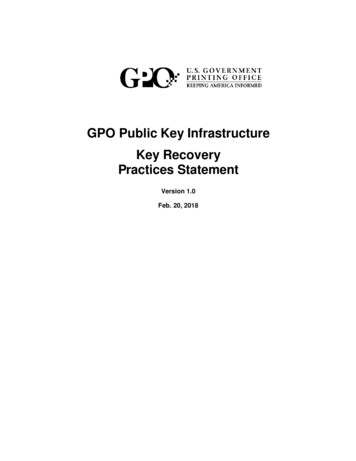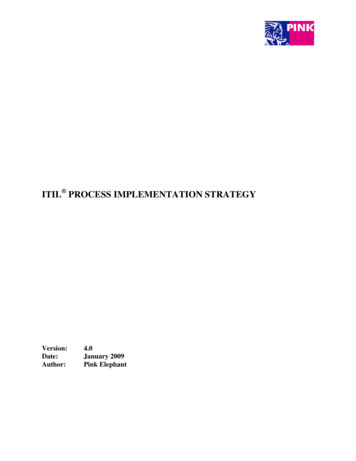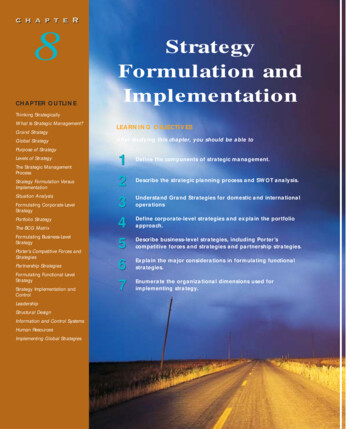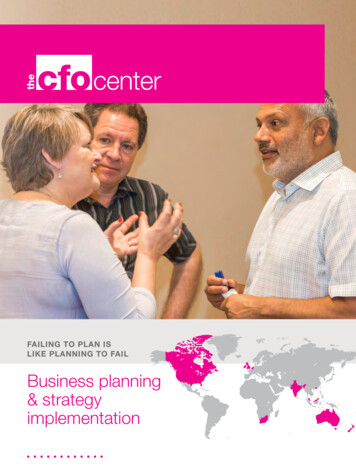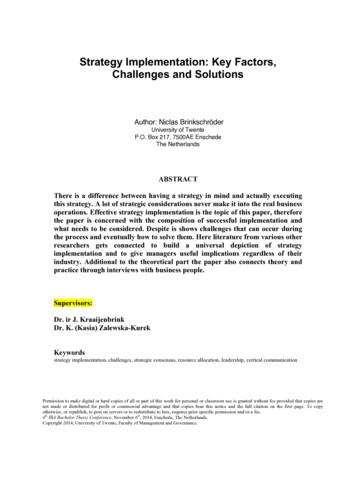
Transcription
Strategy Implementation: Key Factors,Challenges and SolutionsAuthor: Niclas BrinkschröderUniversity of TwenteP.O. Box 217, 7500AE EnschedeThe NetherlandsABSTRACTThere is a difference between having a strategy in mind and actually executingthis strategy. A lot of strategic considerations never make it into the real businessoperations. Effective strategy implementation is the topic of this paper, thereforethe paper is concerned with the composition of successful implementation andwhat needs to be considered. Despite is shows challenges that can occur duringthe process and eventually how to solve them. Here literature from various otherresearchers gets connected to build a universal depiction of strategyimplementation and to give managers useful implications regardless of theirindustry. Additional to the theoretical part the paper also connects theory andpractice through interviews with business people.Supervisors:Dr. ir J. KraaijenbrinkDr. K. (Kasia) Zalewska-KurekKeywordsstrategy implementation, challenges, strategic consensus, resource allocation, leadership, vertical communicationPermission to make digital or hard copies of all or part of this work for personal or classroom use is granted without fee provided that copies arenot made or distributed for profit or commercial advantage and that copies bear this notice and the full citation on the first page. To copyotherwise, or republish, to post on servers or to redistribute to lists, requires prior specific permission and/or a fee.4th IBA Bachelor Thesis Conference, November 6th, 2014, Enschede, The Netherlands.Copyright 2014, University of Twente, Faculty of Management and Governance.
1. INTRODUCTION2. LITERATURE REVIEWThe business context of organizations is an ever-changingenvironment. May it be a modified law, an innovativetechnology or a new behavior of people or customers,organizations find themselves often in a different setting andneed to react accordingly. The reaction can result in a change ofstrategy. This strategic change is vital, because it helps to retainor gain competitive advantage in an altered businessenvironment. Strategic change needs planning as a lot of issuesarise and need to be solved. The feasibility and purpose are keyto strategic planning, but also the organizational culture andstructure will play a role in this stage. Strategic change and thesuccessful implementation have one aim, a higherorganizational performance.This paper tries to find out how organizations can effectivelyimplement their well- conceived strategy. By effectiveimplementation a superior performance and competitiveadvantage is meant. Superior performance in comparison to theprior strategy and competitive advantage that is hard to imitateand that gives the organization a time advance to its rivals in themarket. It is necessary to find out the most important aspects inthe implantation process to be effective and therewithsuccessful. At first it is essential to illuminate the theoreticalwork done by many researchers in the topic of strategyimplementation like Guth, Nobel, Beer and many others onwhich this paper is grounded. The understanding for strategyimplementation grew over time through different researchersand diverse approaches. The literature review is an attempt toconstruct the most comprehensible connection between thedifferent approaches and to involve the most important factorswhen implementing strategy. The approaches developed try tocope with challenges that exist in the organizational setting andmay exist in the beginning of strategy implementation or in itscourse. Only organizations that will overcome these challengeswill be able to implement their strategy effectively which showstheir relevance for this paper. It will be interesting to comparetheory of strategy implementation and practical solutions andapplication in the course of the paper, integrating the insight ofboth to create a universal advise to implementers.The biggest challenge in strategic change is however the phaseafter planning, the successful implementation of the strategythat is needed and developed. This paper will deal with theissue of strategic implementation. As Olson, Slater and Hult(2005) say it, ‘doing is harder than dreaming’. Organizationsinvest a lot of time and resource in the planning of strategy, butvery little of it will get successfully implemented. Research inthis field will lead to a better understanding what can go wrongand why, but also what will foster success. Organizations thatfail to develop its strategy may fail on the long run.Today much is known about the important factors in theplanning phase of strategy. Furthermore problems, whichappear during the implementation phase, are known. Someapproaches and methods have been developed by researchers toensure a structured processing; the most important factors ofthem will be introduced, summarized and connected during thepaper. But a gap still exists between knowing what to do andactually doing it. Thus there is little systematic knowledgeabout how to implement a well-conceived strategy on paper inthe real day-to-day business of an organization. Withouteffective implementation “even the most superior strategy isuseless” as Aaltonen and Ikavalko (2002) realized.The aim of this paper is to outline the challenges and problemsthat can arise and hinder successful strategy implementation, inconnection with it the most important factors that foster it. Butthe most interesting part of the study will be the insights gainedthrough the analysis of interviews from people in practice andtheir solutions to challenges of strategy implementation. Thecomparison of theory and practice might show unexpecteddifferences. The research question is the following:As a point to start the paper will focus on the interplay betweenthree variables, strategy and organizational structure as well asthe connection of both with behaviors of people. In the end theaim of strategic change is an improved organizationalperformance, and the interplay of strategy, structure andbehavior is key to understand how to reach a higherperformance.Pryor, Anderson, Thoombs and Humphreys introduced a similarapproach in 2007: The 5 P’s Paradigm. The authors utilize theterms Purpose, Principles& Processes, People and Performancein their model. Behind those terms all beginning with a P arestrategy (Purpose), structure (Principles& Processes) andBehavior (People). Despite they describe the connectionbetween them as strategy drives structure; structure drivesbehavior; and behavior drives results, in a top-down manner.The following figure shows the connections between the threedifferent parts more intertwined and not top-down, as Strategyalso has direct influence on Behavior and Behavior andStructure also have their influence on Strategy. The balancedinterplay of all three leads to increased performance, which isthe main objective of implementing a new or changed strategy.How do organizations implement their strategy?StrategySubquestions:What are the most relevant factors when implementing nrestrainstrategyStructureBehaviorWhat are the solutions to overcome those challenges?Figure 1: Strategy Implementation setting
From this basic figure it is easier to go deeper into the topic ofstrategy implementation. People and their Behavior play animportant role, as they are the ones who have to act accordingto the organizational strategy. The people act in specificorganizational structures that affect their behavior, but also thebehavior of the people has an influence on the organizationalstructure. All arrows depict the interrelation. Strategy isinfluenced by both and also influences them, as the strategyshall be in accordance to structure and behavior of theorganization to match it. As Pryor et al. (2007) put it, “ whenimplementing a strategy, it’s dangerous to ignore [ ]components because strategy implementation requires anintegrative point of view”, implying that managers and strategyimplementers have to keep in mind the interdependency ofdifferent factors and shouldn’t neglect any. The following tableshows the three key variables of this paper. The existingliterature about strategy implementation developed over yearsand researchers found factors that can be categorized into thethree variables. In the paper all these useful and importantfactors are compiled and ordered. The table shall serve as avisual support; each of the part of the table will be processed inmore detail in the subsequent ningCross-functionalcoordinationCommitment dershipmanagersControlmanagementbyofCultural contextCommunicationTable 1: Key Factors for Strategy Implementation2.1 StrategyStrategy itself can be seen as a plan for an organization. Afterrecognizing the need for strategic change, the manager setsgoals. Then he must determine actions to achieve those goalswith the resources he has available.2.1.1 Formulation and PlanningPlanning and Formulation of the strategy are vital, according toNoble (1999). Prior to the Implementation members of severalfunctions should be involved in the Formulation stage. Thosewho get involved should have credibility, thus other stufffollow their lead and see the importance of change. Thereforethose involved must have a proper knowledge to educate others.In the Planning stage the manager has to organize theimplementation effort successfully. Resources have to beallocated, responsibilities and authorities need to be set andcapabilities and concerns of functions need to be solved.Lorange (1998) is adding to the Planning that strategic planningin the 60s, 70s and 80s was formal, long-term and tended to betop-down and bottom up. He argues that this type of planning isoutdated, because it is rather mechanical and excluded thepeople of an organization. Today the strategic planner must beseen also as a part of the practical implementation. Lorangedefines strategic planning as a “continuously changing portfolioof projects evolving towards completion”. Strategies themselvesbecome more and more incremental as they must be seen inconnection with the growing knowledge base of anorganization. Strategies become continuously redefined as theknowledge of the organization evolves and allows new insight.Thus it is necessary that strategy adapts to the changes andbecome more dynamic and gets consecutively revised. Slaterand Olson (2001) complement that the consistency of strategy isvital, meaning that strategy throughout the company should bein line with the overall direction of the company and its goals.Opposed to their view Govindarajan (1988), recognized that“different business units within the same corporation oftenpursue different strategies and that the administrativemechanism that corporate headquarters use to manage thosebusinesses should differ”. In this paper we follow the opinionthat an organization should move together in one direction andcooperation and harmony will help to implement strategy moreefficiently. Finally Beer and Eisenstat (2000) are mentioning,that responsible people in this phase should consider statingwhat not to do and stressing what is most important, this leadsto a higher understanding of employees that are expected tobehave according to the new strategy.2.1.2 Strategic consensusNoble (1999) already focused on involving people fromdifferent functions, the next important factor is the degree towhich interorganizational strategic perceptions are congruent.In their work Rapert, Velliquette and Garretson (2002) concernthemselves with strategic consensus, in specific on sharedunderstandings and priorities. Consensus is key, becausestrategies can be interpreted in a diverse set of ways. It is themanager’s responsibility to promote and unified direction of thepeople in the organization. Strategic consensus is connectedwith implementation success and increased performance. As amean of enhancing strategic consensus frequent verticalcommunication plays a crucial role. As organizations are socialcollectives the communication is a mechanism to transmit ideasand values and increases the identification, which is also linkedto Noble’s (1999) involvement in the Formulation stage. Rapertet al. (2002) see a lack of clear common understanding as amajor barrier to strategy implementation. This is in line with theopinion of Beer and Eisenstat (2000); organizations would lackstrategic consensus and clarity about goals and direction.Noble(1999) found out, whenpeople have a poorunderstanding of broader scope and goals they are not able towork sufficiently to reach a different organizational stage with anew strategy.Connection of Strategy and Structure and BehaviorOlsen, Slater and Hult (2005) conducted a study in which theyfound out that firm performance is strongly influenced by howwell a firm’s Strategy is matched to its organizational Structureand the behavior of its employees. They saw manyorganizations adopted structures and encouraged behaviors thatreinforce their market strategy and concluded, that firms thatmatch structure and behavior to strategy fare better than thosethat do not. This shows the connection of strategy, structure andbehavior. But differently to Olsen, Slater and Hult (2005) thispaper sees the interplay not only as Structure and Behaviorshould be adapted to Strategy but also that new Strategy shouldbe in line with the existing Structure and Behavior of anorganization, for the reason that these are already establishedand harder to change. If however a radical new Strategy that isnot in line with existing Structure and Behavior, they need to beadapted to Strategy. The influence can happen in bothdirections. Govindarajan (1988) has the same opinion, he said,“matching administrative mechanisms with strategy is likely tobe associated with superior performance”; with administrativemechanisms he means what is known as structure in this p
The literature review is an attempt to construct the most comprehensible connection between the different approaches and to involve the most important factors when implementing strategy. The approaches developed try to cope with challenges that exist in the organizational setting and may exist in the beginning of strategy implementation or in its course. Only organizations that will overcome .






